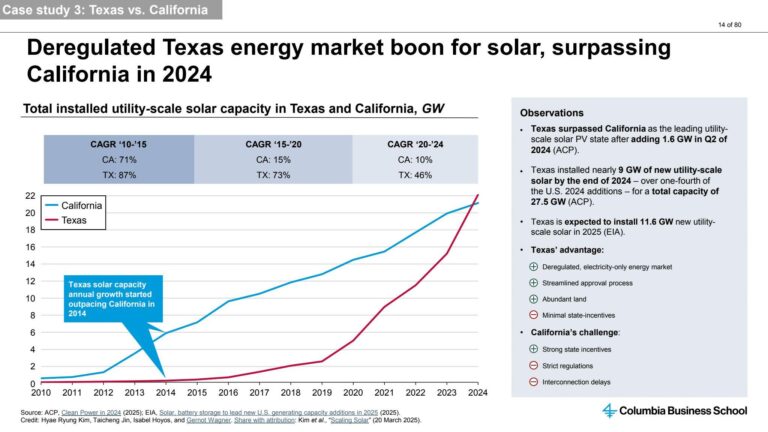Texas Renewable Energy Investment Declines Amid Project Cancellations
In the first half of 2025, Texas experienced a significant downturn in its renewable energy sector, with nearly $4.4 billion in clean energy projects being scrapped. This development signals a major obstacle for the stateŌĆÖs ambitions to broaden its green energy infrastructure. Industry experts point to a mix of regulatory complexities, supply chain disruptions, and escalating material expenses as key factors undermining progress. The affected initiatives, which include wind farms, solar arrays, and battery storage facilities, highlight the instability currently challenging TexasŌĆÖs clean energy expansion efforts.
Among the projects impacted were several large-scale solar and wind power installations that were expected to substantially increase the stateŌĆÖs renewable capacity. The primary reasons behind these cancellations can be summarized as follows:
- Regulatory obstacles: Prolonged permit processes and evolving policy landscapes.
- Supply chain constraints: Scarcity of essential components like wind turbines and solar panels.
- Financial pressures: Rising costs causing budget overruns and investor reluctance.
| Project Category | Investment Amount | Current Status |
|---|---|---|
| Solar Energy Project (West Texas) | $1.3 Billion | Terminated |
| Wind Power Development (Panhandle) | $1.7 Billion | Deferred |
| Energy Storage Facility | $1.4 Billion | Terminated |
Economic and Environmental Consequences of Clean Energy Project Cancellations
The withdrawal of nearly $4.4 billion in clean energy investments has profound implications for TexasŌĆÖs economy and environmental objectives. The immediate fallout includes potential job losses across construction, engineering, and manufacturing sectors tied to renewable energy development, threatening thousands of livelihoods. This disruption underscores the fragile interplay between regulatory frameworks and investor confidence, which has been unsettled by policy ambiguities and market volatility. Moreover, local economies that had anticipated growth from green energy projects now face uncertainty.
Environmentally, these cancellations impede TexasŌĆÖs progress toward reducing greenhouse gas emissions and transitioning to sustainable energy sources. The delay or abandonment of solar, wind, and battery storage projects compromises efforts to combat climate change effectively. Key environmental impacts include:
- Continued dependence on fossil fuels: With fewer renewable projects advancing, reliance on natural gas and coal may persist or increase.
- Stifled technological progress: Reduced funding limits innovation and development in renewable energy technologies.
- Challenges in meeting emissions targets: The stateŌĆÖs ability to achieve its carbon reduction goals is hindered without new clean energy capacity.
| Impact Area | Expected Outcome | Estimated Magnitude |
|---|---|---|
| Employment | Job reductions in construction and operations | Over 5,000 positions |
| Carbon Emissions | Increase in COŌéé emissions | Up to 2 million metric tons annually |
| Economic Activity | Delays in project completions | $1.2 billion loss projected for Q3-Q4 2025 |
Root Causes Behind the Decline in Texas Clean Energy Investments
The sudden halt in clean energy funding in Texas during early 2025 stems from a convergence of factors. Chief among these is the uncertainty surrounding federal policies, including the rollback of certain renewable energy incentives and fluctuating tariffs on imported solar and wind equipment. These changes have dampened investor enthusiasm by increasing perceived risks.
Compounding these issues are persistent supply chain challenges, with rising prices and delays for critical components such as photovoltaic modules and battery systems making projects financially unfeasible. Additionally, local infrastructure limitations, including grid capacity constraints and difficulties integrating new renewable sources, have further restricted project viability.
- Policy instability: Changes in tax credits and regulatory reversals.
- Supply chain disruptions: Elevated costs and delivery bottlenecks.
- Grid infrastructure challenges: Limited capacity for new project interconnections.
| Factor | Effect on Funding | Future Outlook |
|---|---|---|
| Policy Uncertainty | Reduced investor confidence | Potential stabilization with forthcoming federal directives |
| Supply Chain Constraints | Escalated project expenses | Gradual improvement anticipated by late 2025 |
| Grid Capacity Limitations | Restricts project expansion | Requires long-term infrastructure investments |
Pathways to Reinvigorate Texas Clean Energy Investments
Reviving TexasŌĆÖs clean energy investment landscape demands a comprehensive strategy that tackles both regulatory and financial challenges. Accelerating and simplifying permitting procedures can reduce project delays and costs, thereby restoring investor trust. Strengthening collaborations between public entities and private investors can also mobilize capital and foster innovation in renewable technologies. Engaging local communities transparently ensures broader support, which is essential for project success.
Moreover, aligning incentives with evolving market needs and emerging technologies is crucial. Introducing performance-based tax credits and rebates can motivate developers to diversify beyond conventional solar and wind projects, embracing innovations like green hydrogen and advanced battery storage. The following outlines key strategic priorities to stimulate clean energy growth in Texas:
- Regulatory modernization: Streamline environmental reviews and permitting.
- Innovative financing: Expand green bonds and scalable funding mechanisms.
- Technology diversification: Support emerging renewable energy solutions.
- Community involvement: Promote inclusive participation and local benefits.
- Policy stability: Maintain consistent, long-term incentives.
| Focus Area | Expected Benefit | Estimated Timeline |
|---|---|---|
| Regulatory Modernization | Accelerated project approvals | 6 to 12 months |
| Innovative Financing | Enhanced capital availability | 12 to 24 months |
| Technology Diversification | Greater sector resilience | 18 to 36 months |
Final Thoughts on the Future of Texas Clean Energy
As Texas confronts the cancellation of nearly $4.4 billion in clean energy projects during early 2025, the stateŌĆÖs renewable energy outlook faces considerable uncertainty. The response of policymakers, developers, and investors to these challenges will be pivotal in shaping the trajectory of TexasŌĆÖs green energy ambitions. Strategic reforms and renewed commitments are essential to overcoming current obstacles and fostering sustainable growth in this vital sector.




